Community Water Fluoridation
Introduction
Tooth decay is the most common chronic disease for children and teenagers. In fact, tooth decay is four times more common than asthma among teens. One in four working-age adults has untreated cavities. If left untreated, poor oral health can affect people’s overall health. In Texas, more than 1 in 6 third-graders have untreated tooth decay.
Many people suffer from dental disease and pain because they struggle to get regular dental care. Nearly 2.3 million Texans reside in areas with a shortage of dentists. Many others face barriers, such as lacking dental insurance, having a disability or not having transportation. The good news is that Texans can take smart steps at home to prevent tooth decay, and prevention starts with fluoride.
What is fluoride?
 Prevention is the best and most inexpensive way to keep mouths healthy so teeth last a lifetime. Fluoride is a critical part of prevention. Fluoride is a mineral that naturally exists in lakes, rivers, groundwater and even the oceans.
Prevention is the best and most inexpensive way to keep mouths healthy so teeth last a lifetime. Fluoride is a critical part of prevention. Fluoride is a mineral that naturally exists in lakes, rivers, groundwater and even the oceans.
For more than a century, researchers have studied fluoride’s effect on teeth. During the 1940s, research discovered that a specific level of fluoride in water strengthens the tooth enamel, making it more resistant to tooth decay.
Fluoridation & Texas
The natural concentration of fluoride in water is usually too low to protect teeth. This is why so many communities across the nation engage in a process called “community water fluoridation.” Through this process, a local water system adjusts the level of fluoride — generally by adding a small amount of fluoride to reach the level (0.7 milligrams per liter) proven to prevent tooth decay.
The Centers for Disease Control and Prevention (CDC) reports that fluoridation reduces cavities by 25%. No wonder the CDC named water fluoridation as one of 10 great public health achievements of the 20th century. Fluoridated water isn’t just beneficial for children. Research from around the globe reveals that adults also benefit from fluoridation.
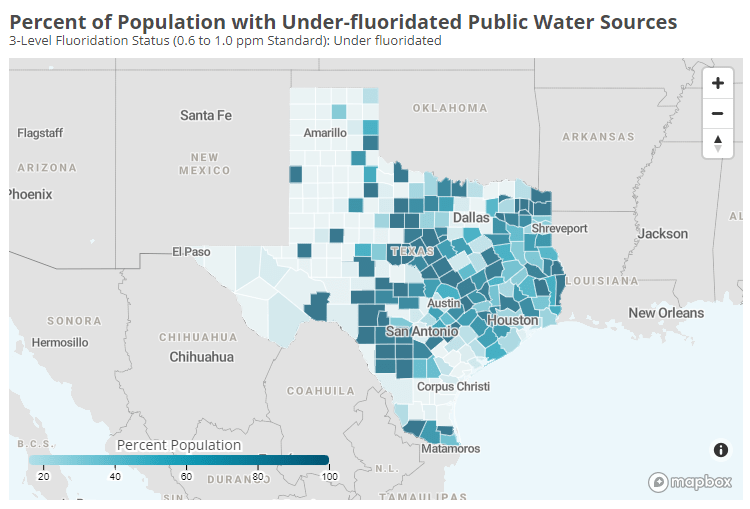
One of the very first U.S. communities to adopt a water fluoridation program was in Texas. Fluoridated water reaches two-thirds of Texans whose homes are connected to public water systems. That’s good news for our teeth.
This map shows the degree to which residents of each Texas county have access to fluoridated water.
Is fluoride toothpaste necessary?
Most brands of toothpaste also contain fluoride. Some people may wonder if it is necessary to get fluoride from both water and toothpaste. The answer is yes! Consider this: When automakers installed air bags in cars and trucks, they didn’t remove the seatbelts. Why not? Because air bags and seatbelts protect people in complementary ways. The same is true for fluoridated water and fluoride toothpaste.
The CDC says that fluoride in both water and toothpaste “provide important and complementary benefits.” When people consume water, iced tea or foods made with fluoridated water, trace levels of fluoride remain in their mouths and combine with the saliva and dental plaque. That’s how fluoride comes in contact with the tooth surface and helps to replace the minerals and make the tooth stronger. Toothpaste has a much higher concentration of fluoride than fluoridated water. Brushing twice each day also helps to remineralize teeth in much the same way.
Fluoridation saves money
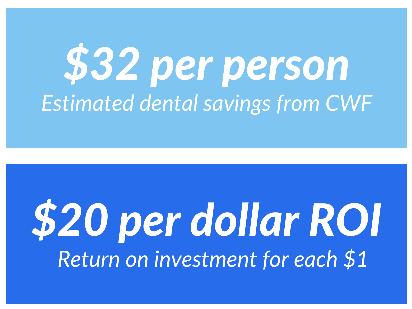 By protecting teeth, water fluoridation helps to save money for families and taxpayers. In fact, a 2016 study showed that each person in a fluoridated community saved an average of more than $32. In fact, the money saved from fluoridation exceeds the costs of adding fluoride, which is why this approach returns $20 for every dollar invested.
By protecting teeth, water fluoridation helps to save money for families and taxpayers. In fact, a 2016 study showed that each person in a fluoridated community saved an average of more than $32. In fact, the money saved from fluoridation exceeds the costs of adding fluoride, which is why this approach returns $20 for every dollar invested.
Years ago, Texas legislators directed the state health department to study the cost of fluoridation and its potential savings. In its report, the department compared the Medicaid costs for treating childhood tooth decay in two urban Texas counties. The report found that annual dental treatment costs for kids in the fluoridated county were $19 lower per child than in the non-fluoridated county. While $19 per child per year may not seem significant, multiply that by the total number of children (3.5 million+) who are enrolled in Texas’ Medicaid program and the total savings would exceed $67 million each year!
Room for improvement in Texas
Unfortunately, Texans in many areas of the state are not getting the benefits of water fluoridation.
These areas fall into two groups:
- Communities that could engage in fluoridation but are not doing so
- Communities where the water has naturally occurring fluoride that is higher than the level recommended by the CDC
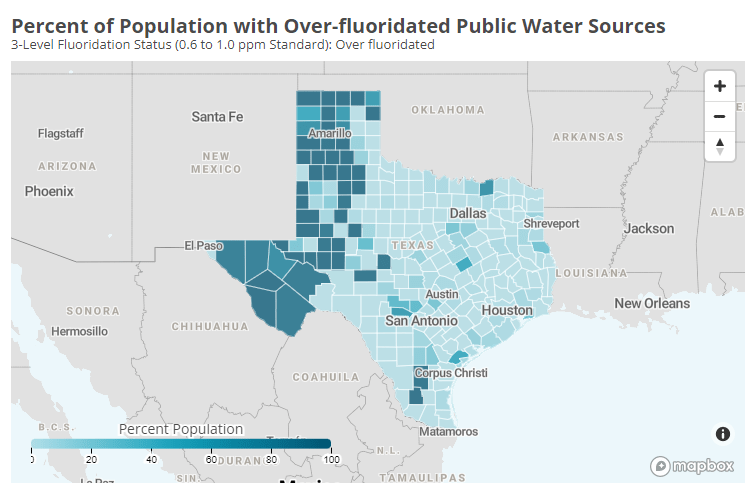
In communities with high fluoride levels, local water systems may be required to inform their customers that the fluoride levels might cause faint white spots (a cosmetic condition called “dental fluorosis”) to appear on the surface of young children’s teeth. A recent study reveals that these spots may diminish over time.
Why do some people oppose fluoridation? Reasons vary, but many of them have formed their beliefs based on false or misleading claims they have read or heard. Independent news organizations have fact-checked several claims that critics make about fluoridation and its safety and found them to be deceptive. Nonetheless, confusion and misinformation have led some communities to end fluoridation.
When community leaders focus on the scientific evidence, they usually choose to continue this proven practice. Dallas and Fredericksburg are among the Texas communities in recent years that have chosen to maintain fluoridation. They made a wise decision because studies show that both the rate of dental decay and the need for dental treatments increase significantly after a community ends fluoridation.
Access to dental care
Access to nearby dentists is vital to preventing oral health problems. In many rural Texas counties, there are no dentists whatsoever. This map shows the dentist rate—that is, the number of dentists per 100,000 residents.
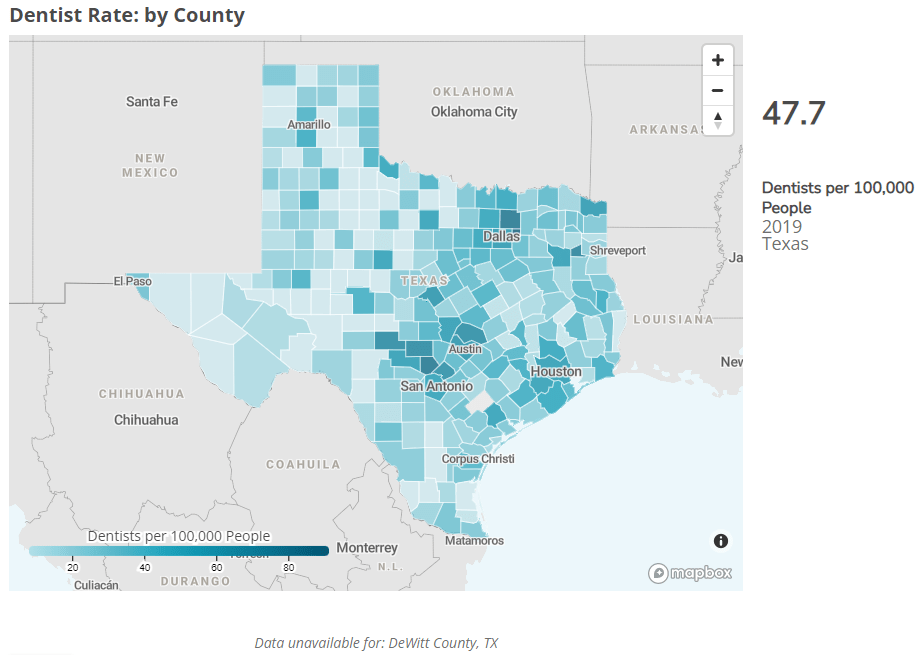
The next two charts show the percentage of adults that self-reported visiting a dentist within the past year. Adults in Texas had a lower prevalence of annual dental visits, compared to the United States as a whole. Those with lower income levels had a lower prevalence of annual dental visits than those of higher income levels.
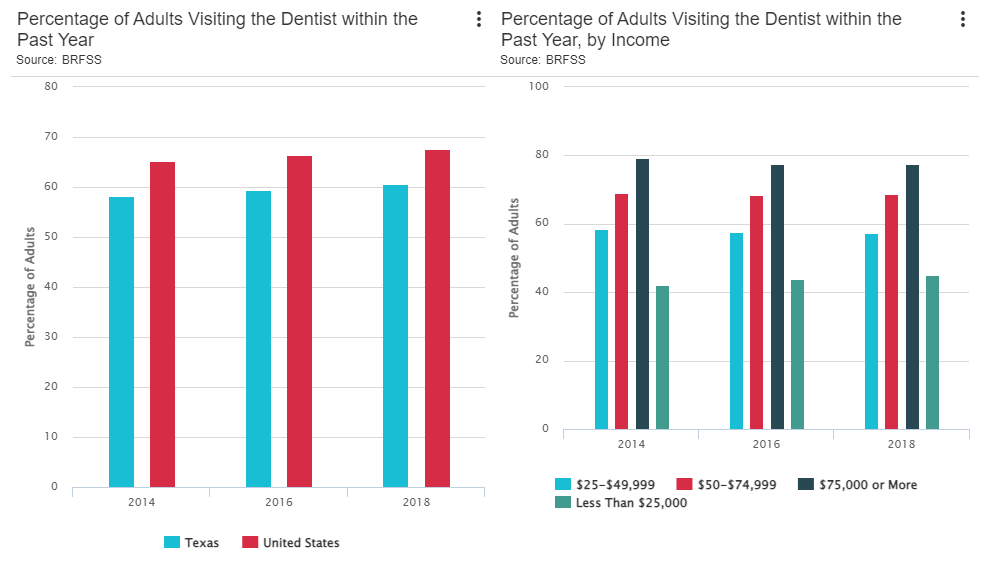
Keeping children’s mouths healthy
 Tooth decay — the disease that is also called “caries” — is the most common chronic disease of children and teens. In fact, tooth decay is four times more common than asthma. Kids who eat a healthy diet and receive fluoride through tap water and toothpaste can keep their teeth free of cavities.
Tooth decay — the disease that is also called “caries” — is the most common chronic disease of children and teens. In fact, tooth decay is four times more common than asthma. Kids who eat a healthy diet and receive fluoride through tap water and toothpaste can keep their teeth free of cavities.
Diets that are high in sugars and carbohydrates create conditions in a child’s mouth that weaken tooth enamel and fuel the decay process. Children who grow up in a community without fluoridated water are at greater risk of decay.
Tooth decay: Texas third-graders
Two-thirds of Texas third grade students have had at least one cavity. Having poor oral health can make it harder to learn. Research shows that children with recent dental pain are nearly 3 times more likely to be absent from school. In addition, children with tooth pain are almost 4 times more likely to have lower grades. Clearly, preventing tooth decay is important to ensure that Texas children are performing well in school.

Untreated tooth decay: Texas third-graders
One in six (17.5%) of Texas third-grade students has untreated tooth decay. This is concerning because if left untreated, a cavity can become a more dangerous infection. In some cases, children and adults have died in the U.S. because of complications arising from tooth decay.

Treatment needs: Texas third-graders
In Texas, 1 in 7 third-grade students (14%) had early treatment needs, which include the need to treat decay that has not yet caused pain. Urgent treatment needs describe a situation when a child requires care within 24 to 48 hours because of pain, swelling, and/or a serious infection in the mouth or teeth. The most recent Texas oral health data showed that 3% of third-graders had urgent treatment needs.

Dental Health & Kindergarten
In Texas, 53% of kindergarten students have experienced a cavity. Tooth decay for children at this age level is more common in low-income families. One in five kindergarten students in Texas has untreated decay. Oral health disparities exist in Texas, and this age is no exception. For example, Hispanic (58%) and Black (51%) children in Texas kindergarten classes are more likely to have experienced a cavity than White kids (46%).

Data & resources

My Water’s Fluoride
My Water’s Fluoride is a website managed by the Centers for Disease Control and Prevention that allows users to learn about the fluoride level in their drinking water. To navigate to your water system, first select your county. Then, you can review all the water system addresses and fluoride information about them. You may need to call or email your water utility company to find out the correct water system name for your household or work address.
Additional Resources
Texas Oral Health Coalition | TxOHC is a statewide nonprofit whose mission is to lead efforts to achieve optimal oral health across the lifespan.
CDC: Oral Health Basics | A guide to oral health, from the Center for Disease Control and Prevention.
About the Data
Fluoridation by county: LiveStories aggregated and calculated data reported by the CDC to create these maps.
Dentist rate: Data is from the Texas Department of Health and Human Services, Supply and Distribution Tables for State-Licensed Health Professions in Texas.
Cost savings by county: Values shown are computed from the fluoridation data and the county’s population. Population numbers are from Texas Department of Health and Human Services. Data is for 2018.
Tooth decay: Data is from the Texas Department of Health and Human Services Basic Screening Survey (BSS), Third Grade BSS Overall Findings (2017-2018) report prepared by DSHS Maternal and Child Health Epidemiology Unit. The school-based BSS is conducted every five years to assess the oral health of Texas students and monitor changes over time.
Untreated tooth decay: Data is from the Texas Department of Health and Human Services Basic Screening Survey (BSS), Third Grade BSS Overall Findings (2017-2018) report prepared by DSHS Maternal and Child Health Epidemiology Unit. The school-based BSS is conducted every five years to assess the oral health of Texas students and monitor changes over time.
Treatment needs: Data is from the Texas Department of Health and Human Services Basic Screening Survey (BSS), Third Grade BSS Overall Findings (2017-2018) report prepared by DSHS Maternal and Child Health Epidemiology Unit. The school-based BSS is conducted every five years to assess the oral health of Texas students and monitor changes over time.
Dental Health & Kindergarten: Data is from the Texas Department of Health and Human Services Basic Screening Survey (BSS), Kindergarten BSS Oral Health Disparities report prepared by DSHS Maternal and Child Health Epidemiology Unit. The school-based BSS is conducted every five years to assess the oral health of Texas students and monitor changes over time.
